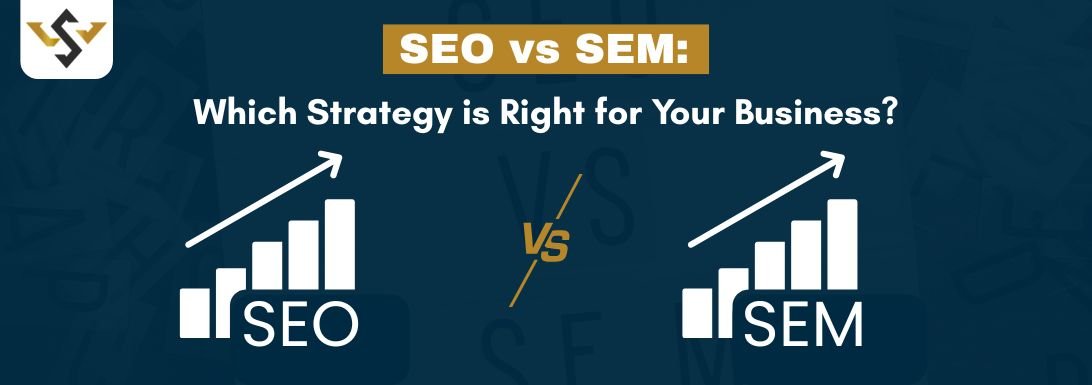If you run a business today, you already know that search engines are like storefronts for the whole web. Each day, billions of searches are made, and that traffic can lead to more sales. However, showing up where potential customers can see you is not always easy, and you might be wondering: should I put my time and budget into SEO vs SEM strategy? Both approaches can help you get found, but they do so in very different ways. This post breaks down those differences, the pros and cons of each, and how to pick the one that will help you drive the most value.
What is SEO?
Search Engine Optimization, or SEO, is the practice of making your website more attractive to search engines so you can rank higher and do it for free. Here are the main types of work involved:
- On-Page SEO: This means tweaking the things you see on a web page, including title tags, headers, keywords, and the actual text.
- Off-Page SEO: Here we look beyond the site. This includes earning quality backlinks, getting featured in guest blogs, and generating engagement on social media.
- Technical SEO: This side ensures the site runs fast, works well on smartphones, and can be crawled easily by search engines.
Unlike paid ads, search engine optimization (SEO) doesn’t drain your budget each month. It focuses on crafting a solid, long-lasting presence online. Think about when you type “best coffee shop near me” and the site you love pops up first, free of charge. That’s a small win for SEO.
What is SEM?
Search engine marketing (SEM) boosts your visibility through paid strategies. It centers on techniques like Pay-Per-Click (PPC) ads, Google Ads, and display-marketing efforts. With SEM, you can handpick your audience by age, zip code, or online behavior, making it a quick route for attracting new visitors. For example, when you debut a trendy new coffee blend and need buzz right away, SEM can zip your ad to the prime real estate on search-result pages.
Difference Between SEO and SEM
When comparing SEO vs SEM marketing, a few main points stand out:
- Cost: SEO is a smart long-term budget move; SEM calls for steady ad spending.
- Speed: SEM fireworks show up fast, while SEO is a gradual glow.
- Sustainability: SEO keeps giving for free after the debut; SEM turns off when the budget does.
- Targeting: SEM lets you narrow your audience like a sniper, and SEO trusts high-quality, broad content to draw visitors.
Businesses can choose the best strategy if they know the SEO and SEM difference. Some people choose SEO because it gives them steady, long-term results. Others choose SEM because it helps them expand quickly.
SEO vs SEM Advantages and Disadvantages
Evaluating the seo vs sem advantages and disadvantages to make the decision clearer:
Advantages of SEO
- Builds long-term credibility and trust.
- Lower ongoing costs since there’s no constant ad buy.
- Organic results generally get more clicks than ads.
Disadvantages of SEO
- It may take six months or longer to see noticeable results.
- Search engines often change their algorithms, which can hurt rankings.
- Consistent work on new content and site fixes is a must.
Advantages of SEM
- Traffic and visibility can start within hours, not months.
- Targeting can be very specific by age, location, interest, and more.
- Good for short-term boosts, seasonal sales, or new product launches.
Disadvantages of SEM
- Click costs can add up quickly, particularly in crowded markets.
- Once you stop paying, the visibility usually stops right away.
- Campaigns need ongoing tweaks to avoid wasting money.
SEO vs SEM Examples
Real-world seo vs sem examples make these strategies clearer:
- SEO Example: A travel site that writes detailed advice and uses well-picked keywords in titles and meta descriptions might rank naturally for “best destinations in Europe.”
- SEM Example: A hotel chain creates Google Ads for “last-minute Paris hotels” to fill rooms immediately, using ad extensions for phone numbers and location.
Both examples show how brands in travel and hospitality effectively choose between or combine SEO and SEM.
When to Choose SEO
Choose SEO when:
- You want to create a brand that sticks around for years.
- Your site gets most of its sales and visitors from search through articles, online stores, or local service pages.
- You need a low-cost option but can trade money for time.
Sustainability is in your plan, and that’s where SEO shines. Extras like writing keyword-targeted content, optimizing for your town, and fixing site speed issues will keep boosting your rankings month after month.
When to Choose SEM
Use SEM when:
- You need visitors now, maybe you’re promoting a festival next weekend or a brand-new product.
- Search results are crowded, and you can’t rank for your keyword without a paid ad.
- You want to explore what buyers want using short, focused ad tests.
An online store launching cameras, for example, can run paid ads for quick traffic while SEO slowly creates strong, free rankings in future months.
A Hybrid Approach: Combining SEO and SEM
The smartest companies don’t stick to SEO vs SEM. They run paid ads for quick results and, at the same time, write great, free articles that pay off later. For example, a brand might bid on ads for a super-competitive word and at the same time write helpful guides that rank for longer searches.
Running ads also tells you what’s working. For instance, the ad reports show which phrases are turning visitors into buyers. Later, you can add those terms to your free SEO list, using the data you learned to write effective, free articles next month.
Beyond Basics: Adding New Marketing Layers
SEO vs SEM marketing comes up all the time, but don’t stop there. Topping off your strategy with these layered approaches can add range without complicating the view:
- Content Marketing: Make guides, blogs, and how-to videos to show your industry knowledge and keep visitors engaged.
- Local SEO: Optimize homepage tags and Google listings to pop up for “near me” inquiries, drawing foot traffic to your store.
- E-commerce SEO: Shopify shops get more attention with on-page optimization, highlighted snippets, and optimized title tags. Want to learn more about Shopify SEO services?
- Social Media Advertising: Expand reach on channels like Facebook, Twitter, or LinkedIn, crafting targeted campaigns to drive traffic.
Working these extra layers keeps you balanced and moves brand campaigns off a single traffic channel.
The Role of Analytics in Decision Making
Whether leaning on organic or paid ads, KPIs inside Google Analytics, SEMrush, and similar tools guide you. Focus on these measures:
- Growth in organic traffic.
- Conversion percentages tied to paid campaigns.
- Keyword rankings over time.
- Overall ROI and cost per acquisition.
With the right KPIs monitored, you can pivot toward tactics that deliver the most impact. Involve the right dashboard, and strategy starts as a guide, not a guess.
Expert Guidance Matters
SEO vs SEM questions can paralyze, in part because budgets and business goals shape each decision. Partner with a seasoned advisor. Someone such as an experienced SEO company in ahmedabad can cut through the confusion, aligning techniques with your products, region, and timeline. Set the right course, and brand visibility comes from you, not guesswork.
If you want to grow smart, looking into seo packages in india gives you a way to plan how to spend your money. Likewise, tapping into local seo services helps your business show up first in searches made by nearby customers.
To dive deeper into SEO methods, the linked piece on On-Page vs. Off-Page SEO shows how to build your website’s authority.
The Future of SEO vs SEM
Search marketing keeps changing. Voice search, AI that personalizes results, and information that appears directly on the search page are changing user behavior. Companies that mix SEO with SEM are staying a step ahead.
- AI in SEO: New tools can forecast search patterns and how users are expected to act.
- Automation in SEM: More intelligent bidding techniques are designed to get you the most return.
- User Experience (UX): Search engines are rewarding sites that load fast and are easy to use.
Keeping up with these updates keeps your business in the lead.
Conclusion
There will always be talk about whether to use SEO vs SEM. The right choice will depend on what your business needs. SEO gives you a long-running advantage, while SEM can drive quick traffic. By grasping the difference between SEO and SEM, weighing pros and cons, and looking at case studies, you can develop a balanced plan that fits your company best.
When it comes to growing your business, you can’t get stYou can’t get stuck in one lane; whether you rely on organic reach, run paid ads, or use a combination of both, agility is your best friend. your best friend. Track what the data is saying, shift your strategy on the fly, and don’t pit one channel against the other. The real win comes in weaving them together so that each one boosts the other. In the end, that balanced approach delivers not just quick wins but the kind of steady, long-term growth that lasts.

